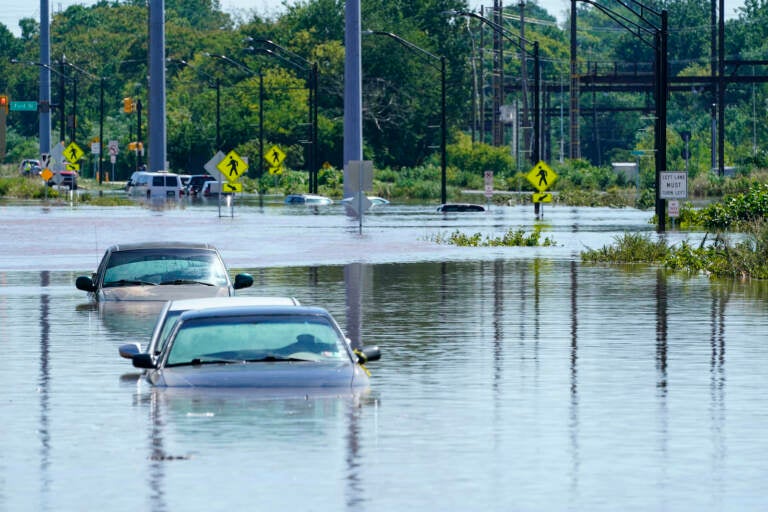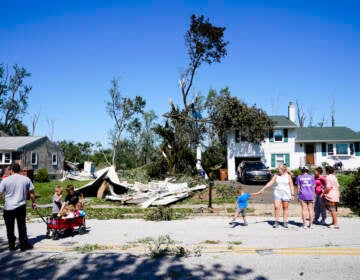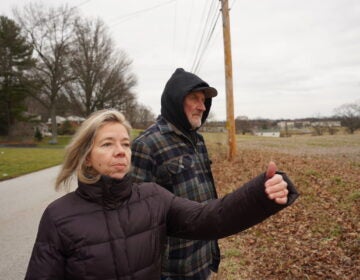How is Montgomery County preparing for future floods?
The county is now acquiring land where three homes were damaged by Hurricane Ida along the Perkiomen Trail in Perkiomen Township, on a flood plain.

File photo: Vehicles are under water during flooding in Norristown, Pa. Thursday, Sept. 2, 2021 in the aftermath of downpours and high winds from the remnants of Hurricane Ida that hit the area. (AP Photo/Matt Rourke)
Got a question about life in Philly’s suburbs? Our suburban reporters want to hear from you! Ask us a question or send an idea for a story you think we should cover.
It’s been seven months since Hurricane Ida wreaked havoc in the Philadelphia region. Severe flooding and damage to homes left 142 families, 316 people, displaced in Montgomery County, living in the county’s emergency hotel rooms, as of January 2022.
Montgomery County is now acquiring land where three homes were damaged by Hurricane Ida along the Perkiomen Trail in Perkiomen Township, on a flood plain.
The county’s Planning Commission said it was offered the land by the homes’ residents.
“They were ready to move on, and this flood had put them over the edge of being able to tolerate a flood again like this, it’s a pretty traumatic event,” said Bill Hartman, the county’s Open Space Section chief.
The Planning Commission intends to leave the land as open space to increase access to the Perkiomen Trail.
Leaving it open will tangentially help mitigate future flooding in the area, said Scott France, Executive Director of the Planning Commission.
“By removing impervious surface and naturalizing it we are enhancing the ability for that corridor to retain more water, slow down the flow of it,” said France.
While this kind of “micro-transaction” won’t stop a major flood like Ida, they are happening all over the place, said France, and collectively, will help mitigate stormwater.
River floods are becoming larger and more common in the Northeast, according to the United States Environmental Protection Agency. A February 2022 study by the Nature Climate Change projects projected that the number of people in the United States who are exposed to flooding will almost double over the next 30 years. And Grist reports that development is largely to blame for increased flood risk.
Beyond the land acquisition, the Planning Commission is hoping to get just under $500,000 in American Rescue Plan funds through the County’s Recovery Office, to put together a countywide stormwater mitigation plan.
The Planning Commission intends to look at all of Montgomery County’s watersheds and point to issues that lead to flooding.
“We’d like to do one that updates [plans on] all the watersheds to some degree and then can put some more focus on those that don’t have plans in place or aren’t as far along,” said France.”
France said he wants that information to encourage and enable municipalities to implement their own storm water mitigation plans and to make it easier to apply for grant money.
The Montgomery County Recovery Office has been calling for grant submissions from community members, organizations, and municipalities for American Rescue Plan funds. The county has about $162 million to spend on projects in the county. Municipalities can apply for grants for projects specifically related to mitigating stormwater.
Stormwater mitigation on a municipal level
Norristown created a Stormwater Authority in January 2022. It has six stormwater mitigation plans in the design phase, according to Rebecca Smith, the Authority’s president. She said they are hoping that shovels will hit the ground on those projects this summer.
Norristown is also in the process of putting together a collective grant package with the Norristown Area School District, the Norristown Area NAACP, and the Stormwater Authority for American Rescue Plan funds.
“Applying and winning a grant is really the only way the borough would see county support for things like a storm water project,” said Smith.
Smith hopes that municipalities can work together on projects in the future.
For instance, Smith said Norristown is downstream from Stony Creek, and so it’s impacted by development there. With an increased amount of impervious surface, Norristown faces increased water runoff, said Smith.
Norristown can’t fix that without collaborating with its neighbors. “Water doesn’t just listen to local boundaries, and I think that we will have to work past local boundaries to address it,” said Smith.
She also said she would like Norristown to receive more state and federal support for large projects that would impact a collection of municipalities, like river dredging.
The Stormwater Authority will be collecting a stormwater management utility fee from residents starting in 2023. That money, said Smith, will allow Norristown to sustainably manage Norristown’s stormwater pipes, which stretch about 33 miles long.
“If we were to compare it to the pipes for water service or sewer service, it’s about the same amount of pipe,” said Smith.
In response to a residents’ question about why Norristown created a new authority for stormwater, Smith said there should be a mindset shift among community members, community leaders, and state and federal leaders, “into thinking about managing stormwater as if it was any other kind of infrastructure.”
David McMahon, a Norristown resident, said he residents have concerns about the accumulation of fees. In the end, he said he hopes the municipality is thinking about stormwater mitigation and energy sustainability plans 50 years into the future.
He said he’d like all new developments to be looked at through that lens, so that plans around storm water are “built into the original concept.”
Municipalities across Montgomery County are making stormwater mitigation plans.
Bridgeport Borough was one of the hardest hit areas in Montgomery County.
In November 2021, 380 people in Montgomery County were living in hotel rooms. About one-quarter of them were from Bridgeport, where 300 people were evacuated from their homes and 500 were temporarily displaced.
Bridgeport created a flood review panel after Hurricane Ida, tasked with reviewing the preparation and response to Ida before, during, and after the disaster, according to Keith Truman, Bridgeport Borough manager.
Bridgeport is reinforcing its emergency response protocols, including implementing a “reverse 911,” which allows the borough to send automated calls and messages to residents’ mobile devices leading up to emergencies.
Tony Heyl, vice president of Bridgeport Borough Council, said the borough is also putting together internal committees on stormwater mitigation implementation.
The borough is conferring with their engineer on new developments and their impacts on stormwater on a case-by-case basis.
“We’re looking at where the water has gone and we’re trying to make sure that development doesn’t all happen in the same place,” he said. “It’s not necessarily about stopping [development]. But just making sure that when development happens, that we have a clear plan for safety and flooding.”
Heyl also hopes that municipalities can start working together, and share creative solutions with each other.
“Local government isn’t helpless. You can do small things,” said Heyl. “If every borough is doing those things, then we can all make a difference together.”
WHYY is your source for fact-based, in-depth journalism and information. As a nonprofit organization, we rely on financial support from readers like you. Please give today.








